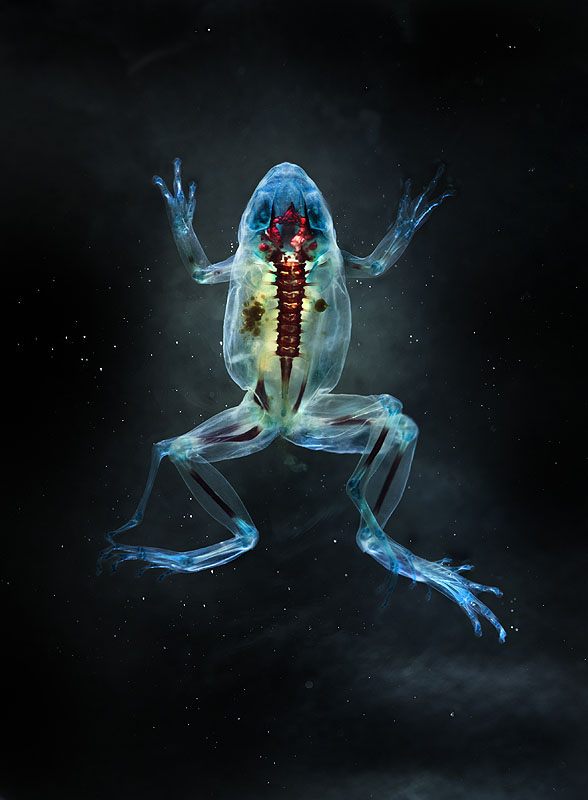
(DFA 186: Hadēs. 2012. Unique digital-C print on watercolor paper. Cleared and stained Pacific tree frog collected in Aptos, California in scientific collaboration with Stanley K. Sessions. 46 x 34 in. )
Creating Fertile Soil In the Face of Loss:
Brandon Ballengée on his Art, Research and Activism
Interviewed by Olivia Ann Carye Hallstein
Brandon Ballengée is an incredible artist, scientist and activist whose work has consistently revolved around endangered species awareness and habitat rehabilitation. His work spans from interactive sculpture to educational environments to community and environmental activism, as well as collage, photography and painting alongside his research. He has recently been awarded a Guggenheim Fellowship for his work in the Gulf of Mexico where communities meet to create, learn and strategize solutions to one of the USA’s largest natural disasters.
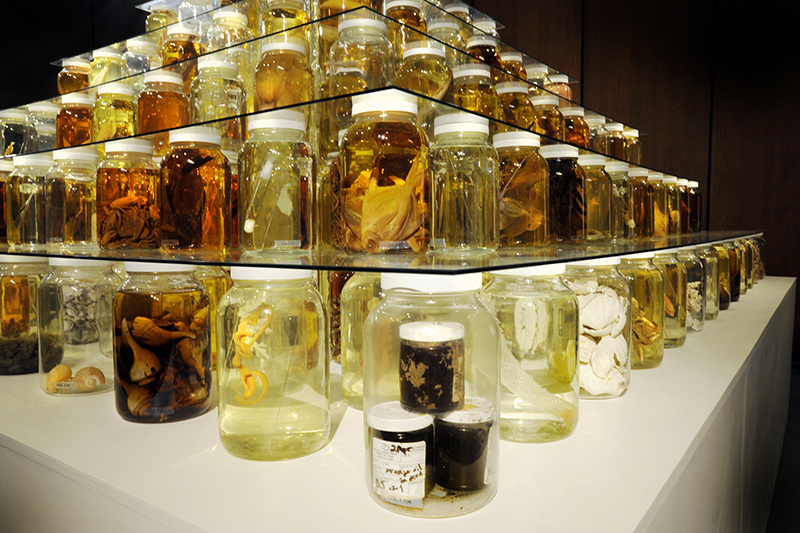
(Collapse. Installed at National Academy of Sciences, Washington, DC, 2014. Mixed-media installation including 26,162 preserved specimens representing 370 species. Glass, Preffer and Carosafe preservative solutions. 12 x 15 x 15 feet. In collaboration with Todd Gardner, Jack Rudloe, Brian Schiering and Peter Warny. Photo by J.D. Talasek.)
Hi Brandon, thank you so much for your time!
Endangered species has been a theme of your work throughout your career. You create awareness for 10s of thousands of species that are disappearing using an array of methods, both creative and scientific. How do you balance and respond to this theme using these different perspectives?
We are in the middle of a mass extinction event, referred to as the Anthropocene or Sixth great extinction. Here, many familiar species, like frogs, turtles, butterflies, and bumblebees are disappearing… and rapidly. We have lost over forty percent of amphibians and more than half the planet’s overall wildlife since I have been alive. The renowned scientist and environmental philosopher Edward O. Wilson has even described this era as the Eremozoic (eremo coming from the Greek for lonely or bereft) or the ‘Age of Loneliness.’
My work responds to the extinction crisis through diverse media and actions. As an artist, I have continued to develop an aesthetic of ‘loss,’ giving a visual form to the growing absence of life on our rapidly degrading planet. As a scientist, I find it increasingly important to share research findings about such losses with the public. Through art, I am able to speculate future outcomes, question our current behaviors, express my concerns as well as mourn. As a biologist, I must remain analytical and report unbiased information on species found within or missing from ecosystems.
Combined, art and science are complementary ways of trying to understand our world and ourselves, as well as a means to address the complex socio-ecological challenges we and other species currently face.

(Styx: Variation Vl. 2010. Parco Arte Vivente (PAV), Centro D'Arte Contemporanea, Torino, Italy. Mixed media installation with 9 cleared and stained Pacific treefrogs on sculptural light-box. In scientific collaboration with Stanley K. Sessions. Photograph by Valentina Bonomonte.)
This is my way of being an activist, an Ecosystem-Activist. I work to activate communities, perform participatory science, encourage artistic expression and infect with ideas, and to concretely push back against habitat degradation, protect the remaining biodiversity and give means for it to regenerate.
Your statement of intent is a call for collaboration between disciplines especially in the arts and sciences. Have your experiences of interdisciplinary collaboration been fruitful? And what are some important things for collaborators between the artistic and scientific disciplines to keep in mind? What is are the important differences between multidisciplinary and transdisciplinary in your opinion?
No single discipline can ‘fix’ the milieu of challenges we currently face. My work with Louisiana communities over the past decade has taught me that art can be an important icebreaker for meeting residents and act as an olive branch with fisherfolk and oil workers, many of whom remain resistant to the concept of human caused environmental impact. At the same time, they are among those facing the greatest threat to their culture and livelihoods from climate change. Through pop-up exhibitions and participatory citizen science, I have been able to meet and recruit potential project participants, communicate my environmental concerns and learn about their perspectives, while brainstorming creative ideas towards survival.
This way of working involves both the utilization of artistic and scientific techniques. The art is often an expression derived from scientific research experiences with animals in natural or artificial conditions and often inspires new ideas for scientific studies. While conducting primary biological research, scientific methods and standards are rigorously followed, however new ideas for art often happens. All inspire and inform further conservation actions.

(Still from North Troy Eco-Action with Brandon Ballengée, 2014)
Through public programs, my Eco-Actions, I share both science and art methods with participants. This is my way of being an activist, an Ecosystem-Activist. I work to activate communities, perform participatory science, encourage artistic expression and infect with ideas, and to concretely push back against habitat degradation, protect the remaining biodiversity and give means for it to regenerate. This mixed method begins as interdisciplinary, becomes multidisciplinary and perhaps moves towards transdisciplinarity where art, science and activism grow with a community into something else.
I think many people can relate to the Age of Loss and Loneliness. Perhaps the last year can lead to more awareness and respect for other species. What can the audience do to stop so many species from being endangered or does the issue lie in necessary changes to big industry?
We are the change. The actions we take every day shape the environments around us, the ecosystems around us, the species around us. What we're choosing to consume, how we're transporting ourselves to different places, what we're doing in our back yard or on our rooftop, or not doing - all of these actions have an impact, and they can be very positive. By using the creative side of art, science, and just being individual human beings working together, we have this remarkable ability to restore environments and help them and other species. Life wants to persist if we let it. Which in turn helps us, too.
Following this concept, my family (my wife Aurore Ballengée and our children Victor and Lilith) and I began the Atelier de la Nature. In 2016, we purchased heavily farmed land in rural south Louisiana and have worked to regenerate the ecosystems from a GMO monoculture into a nature reserve and outdoor education center.
Through sculpting the lands with specialized native species (helping to break-down pesticide residue and deter erosion), we are working to reestablish ‘Cajun’ prairie (ecosystems found here prior to modernity), planted over 1300 regional native trees (to regrow a forest), created wetlands (habitats for declining amphibians and rare fishes), created pollinator habitats from native hibiscus, swamp milkweed, and many more regional plants (to aid declining butterflies, like the Monarch which is in on the verge of endangered, native bees and others) and traditionally grow food without pesticides using permaculture, Creole and other indigenous methods.
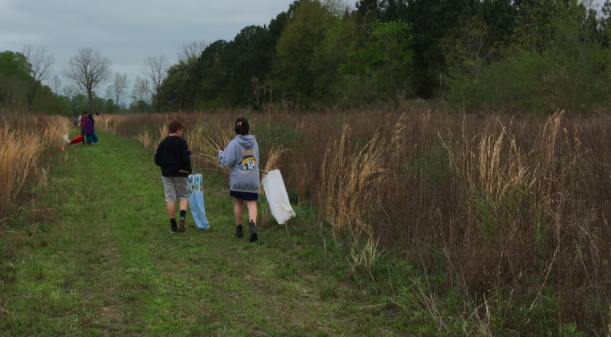
Atelier de la Nature is also a community space, whereby we offer combined environmental education, sustainable food and art events open to all ages. We hold nature summer camp for youth, art and nature festivals for families and have started an artist, and/ or scientist residency program.
Atelier de la Nature project has already yielded results in the ecological sense with many dozens of species of birds and mammals returning (and breeding), amphibians and reptiles currently occupying the property, countless insects, all coming back to once barren land. In the human communal sense, hundreds of youth have helped with restoration of the lands youth or participated in our programs, a thousands have attended our festivals!
I am interested in honoring, remembering, creating an emotional connection with lost species to inspire actions that help to restore ecosystems and save species.
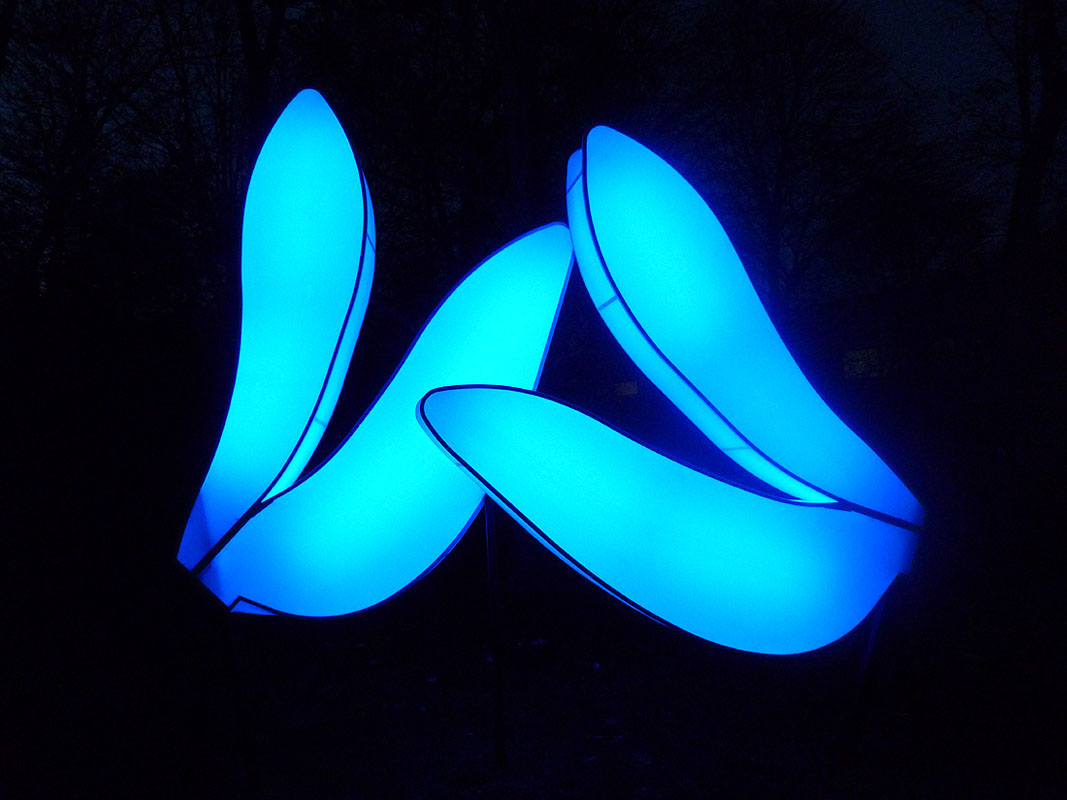
(Love Motel for Insects: Anax Junius Variation. Smithsonian National Zoological Park, Washington DC, USA. Summer 2012. Outdoor installation and Eco-Actions (public field-trips) with: Black Ultra-violet lights, steel, fabric, native plants, invited insects. Overall dimensions 5.5 by 9 meter. Photographs by Lindsay Wallace and Brandon Ballengée.)
That’s beautiful! So many species are affected by human-made constructions (like monocultures in agriculture), and, as you rightfully say, the potential for change lies in our hands. In much of your work you document species passing, and you seem to give voice and representation to the lost species. How much of your goal is to create a “haunting” awareness of the destruction, and how much of your goal is honoring and preserving the evidence of human-caused environmental effects?
The work is not about preserving or documenting destruction. Instead, I am interested in honoring, remembering, creating an emotional connection with lost species to inspire actions that help to restore ecosystems and save species. I just see myself as a human being existing in a time of dire socio-environmental crisis, who tries to do something about it, by any means available to me. In ecosystem terms, we are all hearing Nero’s fiddle as our planetary home burns and species diversity rapidly dwindles. I navigate and try to make sense of this enigmatic traumatic terrain utilizing the analytical methods of a scientist while also trying to understand and express this reality in visual terms as an artist.
 (RIP Hare-Indian Dog: After John Woodhouse Audubon. 1949/2014. Artist cut and burnt print hand-colored stone lithograph, etched glass urn, and ashes. 13 5/8 x 16 inches. Species last observed 1800s. Photo by Casey Dorobek.)
(RIP Hare-Indian Dog: After John Woodhouse Audubon. 1949/2014. Artist cut and burnt print hand-colored stone lithograph, etched glass urn, and ashes. 13 5/8 x 16 inches. Species last observed 1800s. Photo by Casey Dorobek.)
That makes sense and I think it is working. Let’s talk about your practice. Do you have any rituals you perform honor the lost species during your process?
Ritual is at the core of my series, Frameworks of Absence. With the Frameworks, I acquire original historic prints picturing now vanished animals and printed at the period when the depicted species became extinct (ranging from the 16th to 21st Century). These original artifacts are then altered by physically cutting the image of the animal from the print. For example, in RIP Labrador Duck: After John James Audubon (1856/2007), the image of the birds was removed from an original Audubon 1856 Royal Octavo (hand-colored by one of Audubon’s sons) printed at the same point in history as the actual species disappeared.
Another, recently completed work RIP Antioquia Beaked Frog: After Paula Andrea (2011/2014), responded to the loss of this amphibian over the past decade and was cut from a signed artist proof published in Columbia in 2011 (cut with the artists consent). Such altered prints are then framed with a glass backing, so that the wall is seen through the absence of the depicted animal, which gives form to the void left by these lost species. The process of researching the extinct animals, finding and acquiring historic depictions in an ongoing ritual for me.
For this second component of the project, the cut animals from the prints are burned and placed in glass vessels etched with the species name. Participants are then asked to scatter these “remains” through their own private cremation ceremonies- a personal ritual of sorts, what I call Actions of Mourning. My intention here is to create an embodied transformative event, like the loss of a loved one and the scattering of their ashes, changes an individual for the duration of their life. In the case of these actions, my hope is to connect individuals to a lost species in the hope that this grief inspires them to help protect the biodiversity that remains.
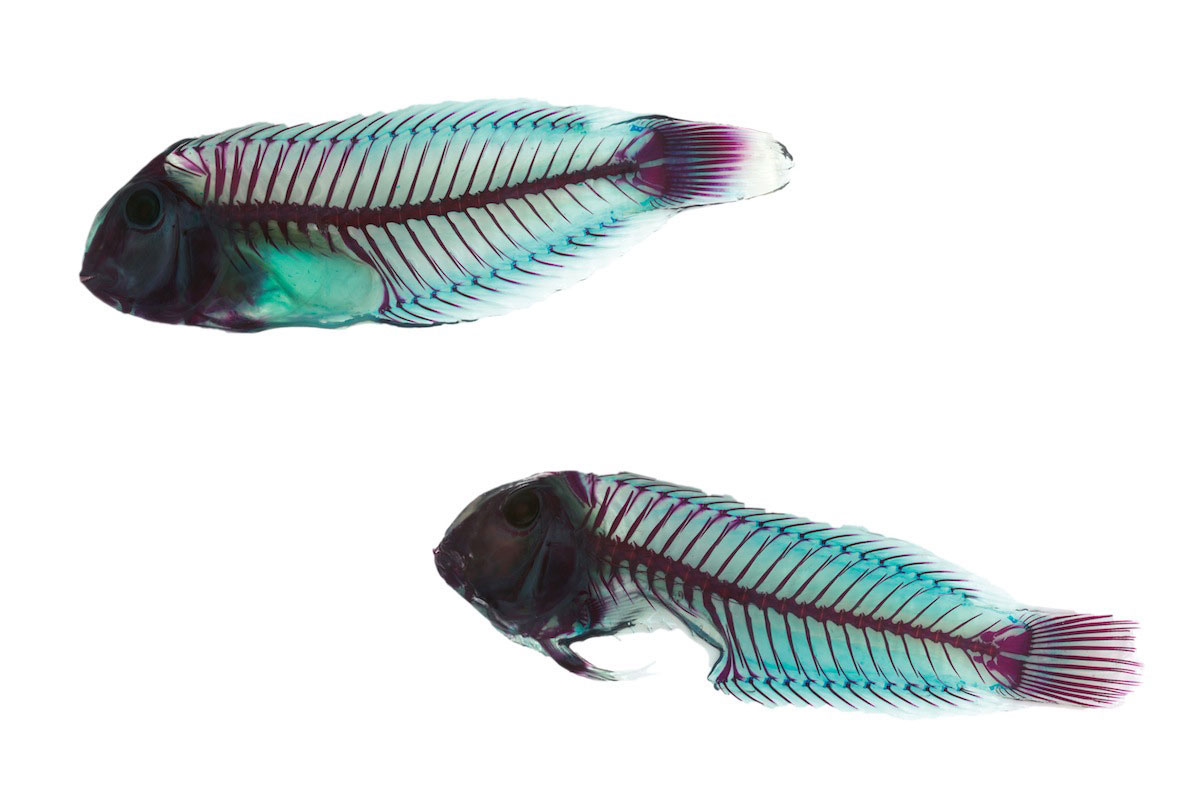
(RIP Parrot Fish. 2014. Giclée print on handmade Japanese rice paper in an edition of 13. 18 by 24 inches each.)
Much of my work attempts to connect viewers with loss, and over the past two decades, through numerous trials using varied media.
These are such touching themes that have really come to the forefront this past year. Due to the pandemic, the human species has been confronted with death like it has not for generations. In your work, “Dying Tree” you amplify the sound of an ill tree dying for a museum audience. What do you think is a healthy relationship with death? And how can the empathy that death creates become a bridge between species?
The death of our friends, family, and ourselves is very hard for us to comprehend. Even further, the permanent loss of a group of organisms is an almost abstract idea. At a larger scale, occidental culture increasingly attempts to “buy” death away. I mean this in two ways, firstly through the preternatural extension of life for those that can afford such “medicine”. Secondly, under postwar capitalism we have been relentlessly trained to consume and accumulate to material goods. The idea that such possessions provide us with happier lives is a widely accepted illusion. Recent studies have shown evidence that individuals thinking about death often respond by going shopping. The COVID over-buying of last year is further evidence. However, if we do not think about loss, how do we grieve, accept or learn from it?

Dying Tree. Domaine de Chamarande, France. Summer 2012.
Much of my work attempts to connect viewers with loss, and over the past two decades, through numerous trials using varied media (such as empty specimen jars to represent changes in marine food-webs, drawn silhouettes of vanished animals, amplifying the sounds coming from a slowly dying tree, and others). I found that the cut artifacts in the Frameworks has a visceral quality that invokes an emotive response in viewers, sometimes anger but most often confusion followed by grief, it has been my successful attempt in translating species loss to others, translate the with the message of species loss. At another level the works question what we value and protect, our beloved depictions of nature or actual species and ecosystems. As conservationist Aldo Leopold once said, “We stand guard over works of art, but species representing the work of aeons are stolen from under our noses.”
From endangered sea turtles, to marine mammals, to plankton, deep-water alga, corals to birds to us- the spill reached the many tiers of the complex Gulf web and way of life.
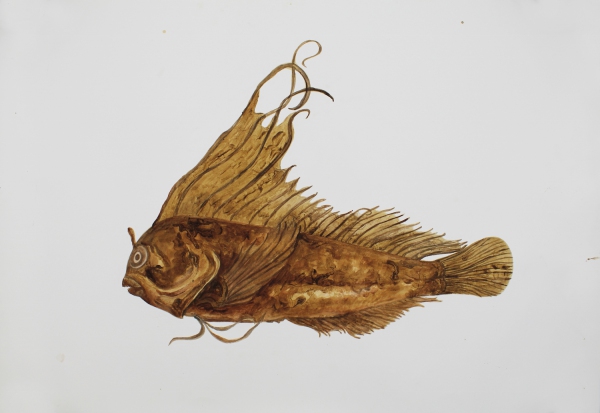
(MIA Highfin Blenny. 2020. 22.5 by 32 inches. Mixed media with Deepwater Horizon source crude oil, Taylor/ MC20 source crude, contaminated marshland sediment with oil, anaerobic bacteria and iron oxide, and COREXIT 9500A (dispersant) on Arches hot press watercolor paper. Depicting United States National Museum of Natural History (NMNH) at the Smithsonian specimen USNM 164017 Highfin Blenny (male), Lupinoblennius nicholsi. *Species last reported in 2000.)
And, last but definitely on least, congratulations on your recent Guggenheim Fellowship! How does it feel and what do you have in store for the fellowship?
Thank you. I am very grateful. The Guggenheim Fellowship will support my continued project Searching for Ghosts of the Gulf, which responds to missing Gulf of Mexico species through visual artworks and actions with coastal Louisiana communities that are themselves culturally endangered.
For many of us, and over ten thousand other species, the Gulf of Mexico is a special place, our sanctuary, our home, our mother, provider and sometimes destroyer. As an artist I find her to be an inspirational source of color, form, intrigue, tranquility and fear. From the science side, the Gulf is among the most important and biologically diverse marine environments in the world. She is resilient, powerful, seductive but also dangerous, damaged and suffocating in her own sang noir (a regional term describing crude oil).
Land in coastal Louisiana is being lost at the fastest rate on Earth and, in recent decades, several Gulf species have gone missing. As habitats and biodiversity disappear, so do the cultures that rely on them. The fate of the Gulf’s children remains precarious.
Since the 2010 Deepwater Horizon (DWH) oil spill, much of my work has focused on the perilous environmental state of the Gulf of Mexico. So much so that my family and I moved to south Louisiana from NYC in 2015, to be at the front lines so to speak.
DWH was the largest industrial petrochemical accident in modern history and its long-term impact on fishes, other biota and Gulf ecosystems is still not well understood. Additionally, there have been 2000+ smaller spills since DWH and, before then, the Taylor or MC20 oil spill began in 2004 and continues uninterrupted today. Through my installations, photographs, crude paintings and programs, I want to give visual form to loss from these environmental insults and inspire individual actions towards systemic change.
The Nature of Art (PBS) 2019